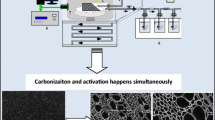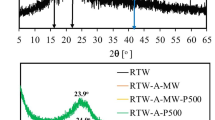Abstract
Empty fruit bunch (EFB) is an industrial waste that is abundantly available in Malaysia. Traditionally, EFBs were burned and dumped on the plantation site, resulting in global warming pollution from methane and carbon dioxide. In this study, the EFB was transformed into a high-surface area of activated biochar through a microwave physicochemical approach involving the combination of steam followed by a hydroxide mixture for palm oil mill effluent (POME) treatment. It was found that BET (Brunauer–Emmett–Teller) surface area and total pore volume of activated biochar were 365.60 m2/g and 0.16 cm3/g, respectively. The surface morphology of activated biochar revealed the formation of well-developed pores that can potentially be used as adsorbents to treat POME. The removal efficiency of biochemical oxygen demand (BOD) and chemical oxygen demand (COD) of POME achieved 75%–55%, respectively. This study offers insight into the transformation of industrial waste into value-added products for sustainable environmental remediation.


Similar content being viewed by others
References
MPOB. 2021. Overview of the Malaysian oil palm industry 2021. Jaya Selangor, Malaysia: Malaysian Palm Oil Board (MPOB).
Sivasamy, V., Yusoff, N., and Abd-Rahman, A. 2020. Powering electric cars in Malaysia with green electricity produced from oil palm biomass. IOP Conference Series: Materials Science and Engineering 736 (3): 032014. https://doi.org/10.1088/1757-899x/736/3/032014.
Ahmad, F.B., Zhang, Z., Doherty, W.O.S., et al. 2019. The outlook of the production of advanced fuels and chemicals from integrated oil palm biomass biorefinery. Renewable and Sustainable Energy Reviews 109: 386–411. https://doi.org/10.1016/j.rser.2019.04.009.
Tao, H.-H., Snaddon, J.L., Slade, E.M., et al. 2018. Application of oil palm empty fruit bunch effects on soil biota and functions: A case study in Sumatra, Indonesia. Agriculture, Ecosystems and Environment 256: 105–113. https://doi.org/10.1016/j.agee.2017.12.012.
Yiin, C.L., Ho, S., Yusup, S., et al. 2019. Recovery of cellulose fibers from oil palm empty fruit bunch for pulp and paper using green delignification approach. Bioresource Technology 290: 121797. https://doi.org/10.1016/j.biortech.2019.121797.
Karunakaran, V., Abd-Talib, N., and Kelly Yong, T.-L. 2020. Lignin from oil palm empty fruit bunches (EFB) under subcritical phenol conditions as a precursor for carbon fiber production. Materials Today: Proceedings 31: 100–105. https://doi.org/10.1016/j.matpr.2020.01.252.
Jabar, J.M., and Odusote, Y.A. 2020. Removal of cibacron blue 3G-A (CB) dye from aqueous solution using chemo-physically activated biochar from oil palm empty fruit bunch fiber. Arabian Journal of Chemistry 13 (5): 5417–5429. https://doi.org/10.1016/j.arabjc.2020.03.020.
Yek, P.N.Y., Liew, R.K., Osman, M.S., et al. 2019. Microwave steam activation, an innovative pyrolysis approach to convert waste palm shell into highly microporous activated carbon. Journal of Environmental Management 236: 245–253. https://doi.org/10.1016/j.jenvman.2019.01.010.
Liew, R.K., Azwar, E., Yek, P.N.Y., et al. 2018. Microwave pyrolysis with KOH/NaOH mixture activation: A new approach to produce micro-mesoporous activated carbon for textile dye adsorption. Bioresource Technology 266: 1–10. https://doi.org/10.1016/j.biortech.2018.06.051.
Tobi, A.R., Dennis, J.O., Zaid, H.M., et al. 2019. Comparative analysis of physiochemical properties of physically activated carbon from palm bio-waste. Journal of Materials Research and Technology 8 (5): 3688–3695. https://doi.org/10.1016/j.jmrt.2019.06.015.
Wong, W.-Y., Lim, S., Pang, Y.-L., et al. 2020. Synthesis of renewable heterogeneous acid catalyst from oil palm empty fruit bunch for glycerol-free biodiesel production. Science of the Total Environment 727: 138534. https://doi.org/10.1016/j.scitotenv.2020.138534.
Zhang, Z., Lei, Y., Li, D., et al. 2020. Sudden heating of H3PO4-loaded coconut shell in CO2 flow to produce super activated carbon and its application for benzene adsorption. Renewable Energy 153: 1091–1099. https://doi.org/10.1016/j.renene.2020.02.059.
Ooi, C.-H., Cheah, W.-K., Sim, Y.-L., et al. 2017. Conversion and characterization of activated carbon fiber derived from palm empty fruit bunch waste and its kinetic study on urea adsorption. Journal of Environmental Management 197: 199–205. https://doi.org/10.1016/j.jenvman.2017.03.083.
Laksaci, H., Khelifi, A., Belhamdi, B., et al. 2017. Valorization of coffee grounds into activated carbon using physic - chemical activation by KOH/CO2. Journal of Environmental Chemical Engineering 5 (5): 5061–5066. https://doi.org/10.1016/j.jece.2017.09.036.
Lai, J.Y., Ngu, L.H., Hashim, S.S., et al. 2021. Review of oil palm-derived activated carbon for CO2 capture. Carbon Letters 31 (2): 201–252. https://doi.org/10.1007/s42823-020-00206-1.
Wu, T.Y., Mohammad, A.W., Jahim, J.M., et al. 2010. Pollution control technologies for the treatment of palm oil mill effluent (POME) through end-of-pipe processes. Journal of Environmental Management 91 (7): 1467–1490. https://doi.org/10.1016/j.jenvman.2010.02.008.
Firdaus, N., Prasetyo, B.T., Sofyan, Y., et al. 2017. Part I of II: Palm oil mill effluent (POME): biogas power plant. Distributed Generation & Alternative Energy Journal 32 (2): 73–79. https://doi.org/10.1080/21563306.2017.11869110.
Abu Bakar, S.N.H., Abu Hasan, H., Mohammad, A.W., et al. 2018. A review of moving-bed biofilm reactor technology for palm oil mill effluent treatment. Journal of Cleaner Production 171: 1532–1545. https://doi.org/10.1016/j.jclepro.2017.10.100.
Mohammad, S.B., Baidurah, S., Kobayashi., et al. 2021. Palm oil mill effluent treatment processes—A review. Processes 9 (5): 739.
Zainal, N.H., Jalani, B.F., Mamat, R. et al. 2017. A review on the development of palm oil mill effluent (pome) final discharge polishing treatments. Journal of Oil Palm Research 29 (4): 528–540. https://doi.org/10.21894/jopr.2017.00012.
Lam, S.S., Liew, R.K., Cheng, C.K., et al. 2018. Pyrolysis production of fruit peel biochar for potential use in treatment of palm oil mill effluent. Journal of Environmental Management 213: 400–408. https://doi.org/10.1016/j.jenvman.2018.02.092.
Tan, Y.Y., Bello, M.M., and Abdul Raman, A.A. 2021. Towards cleaner production in palm oil industry: advanced treatment of biologically-treated POME using palm kernel shell-based adsorbent. Cleaner Engineering and Technology 2: 100079. https://doi.org/10.1016/j.clet.2021.100079.
Razali, N., and Kamarulzaman, N.Z. 2020. Chemical characterizations of biochar from palm oil trunk for palm oil mill effluent (POME) treatment. Materials Today: Proceeding 31: 191–197. https://doi.org/10.1016/j.matpr.2020.02.219.
Liew, R.K., Chai, C., Yek, P.N.Y., et al. 2019. Innovative production of highly porous carbon for industrial effluent remediation via microwave vacuum pyrolysis plus sodium-potassium hydroxide mixture activation. Journal of Cleaner Production 208: 1436–1445. https://doi.org/10.1016/j.jclepro.2018.10.214.
Liu, P., Fan, L., Fan, J., et al. 2021. Effect of water content on the induced alteration of pore morphology and gas sorption/diffusion kinetics in coal with ultrasound treatment. Fuel 306: 121752. https://doi.org/10.1016/j.fuel.2021.121752.
Standardization, I.O. 2021. Evaluation of pore size distribution and porosity of solid materials by 40-point Nitrogen adsorption and 40-point desorption isotherm, ISO 15901-1 Part Number 002-00. Vernier, Geneva, Switzerland.
Pallarés, J., González-Cencerrado, A., and Arauzo, I. 2018. Production and characterization of activated carbon from barley straw by physical activation with carbon dioxide and steam. Biomass and Bioenergy 115: 64–73. https://doi.org/10.1016/j.biombioe.2018.04.015.
Brown, D.M., Hughes, C.B., Spence, M., et al. 2018. Assessing the suitability of a manometric test system for determining the biodegradability of volatile hydrocarbons. Chemosphere 195: 381–389. https://doi.org/10.1016/j.chemosphere.2017.11.169.
Lawal, A.A., Hassan, M.A., Farid, M.A.A., et al. 2020. Production of biochar from oil palm frond by steam pyrolysis for removal of residual contaminants in palm oil mill effluent final discharge. Journal of Cleaner Production 265: 121643. https://doi.org/10.1016/j.jclepro.2020.121643.
Zainal, N.H., Aziz, A.A., Idris, J., et al. 2018. Reduction of POME final discharge residual using activated bioadsorbent from oil palm kernel shell. Journal of Cleaner Production 182: 830–837. https://doi.org/10.1016/j.jclepro.2018.02.110.
He, M., Xu, Z., Hou, D., et al. 2022. Waste-derived biochar for water pollution control and sustainable development. Nature Reviews Earth & Environment 3 (7): 444–460. https://doi.org/10.1038/s43017-022-00306-8.
Kumar, M., Xiong, X., Sun, Y., et al. 2020. Critical review on biochar-supported catalysts for pollutant degradation and sustainable biorefinery. Advances Sustainable System 4 (10): 1900149. https://doi.org/10.1002/adsu.201900149.
Chen, S., Chen, G., Chen, H., et al. 2019. Preparation of porous carbon-based material from corn straw via mixed alkali and its application for removal of dye. Colloids and Surfaces A: Physicochemical and Engineering Aspects 568: 173–183. https://doi.org/10.1016/j.colsurfa.2019.02.008.
Zainal, N.H., Ibrahim, M.F., Jalani, N.F., et al. 2020. Palm oil mill final discharge treatment by a continuous adsorption system using oil palm kernel shell activated carbon produced from two-in-one carbonization activation reactor system. Journal of Water Process Engineering 36: 101262. https://doi.org/10.1016/j.jwpe.2020.101262.
Wafti, N.S.A., Lau, H.L.N., Loh, S.K., et al. 2017. Activated carbon from oil palm biomass as potential adsorbent for palm oil mill effluent treatment. Journal of Oil Palm Research 29 (2): 278–290.
Ibrahim, I., Hassan, M.A., Abd-Aziz, S., et al. 2017. Reduction of residual pollutants from biologically treated palm oil mill effluent final discharge by steam activated bioadsorbent from oil palm biomass. Journal of Cleaner Production 141: 122–127. https://doi.org/10.1016/j.jclepro.2016.09.066.
Priecel, P., and Lopez-Sanchez, J.A. 2019. Advantages and limitations of microwave reactors: from chemical synthesis to the catalytic valorization of biobased chemicals. ACS Sustainable Chemistry & Engineering 7 (1): 3–21. https://doi.org/10.1021/acssuschemeng.8b03286.
Council, N.R. 1995. Prudent Practices in the Laboratory. In: Handling and Management of Chemical Hazards, pp. 139–172. Washington, DC, USA: National Academies Press.
Acknowledgements
The authors thank the monetary support by University of College Technology Sarawak under University Grant Scheme (Project No. UCTS/RESEARCH/4/2018/17) to perform the research. Furthermore, the authors would like to thank all staff for their continuous encouragement and assistance throughout this project.
Author information
Authors and Affiliations
Corresponding authors
Ethics declarations
Conflict of interest
The authors have no competing interests to declare that they are relevant to the content of this article.
Additional information
Publisher's Note
Springer Nature remains neutral with regard to jurisdictional claims in published maps and institutional affiliations.
Rights and permissions
Springer Nature or its licensor (e.g. a society or other partner) holds exclusive rights to this article under a publishing agreement with the author(s) or other rightsholder(s); author self-archiving of the accepted manuscript version of this article is solely governed by the terms of such publishing agreement and applicable law.
About this article
Cite this article
Kong, K.K., Yek, P.N.Y., Sii, H.S. et al. Microwave physicochemical activation: an advanced approach to produce activated biochar for palm oil mill effluent treatment. Waste Dispos. Sustain. Energy 4, 323–333 (2022). https://doi.org/10.1007/s42768-022-00115-1
Received:
Revised:
Accepted:
Published:
Issue Date:
DOI: https://doi.org/10.1007/s42768-022-00115-1




